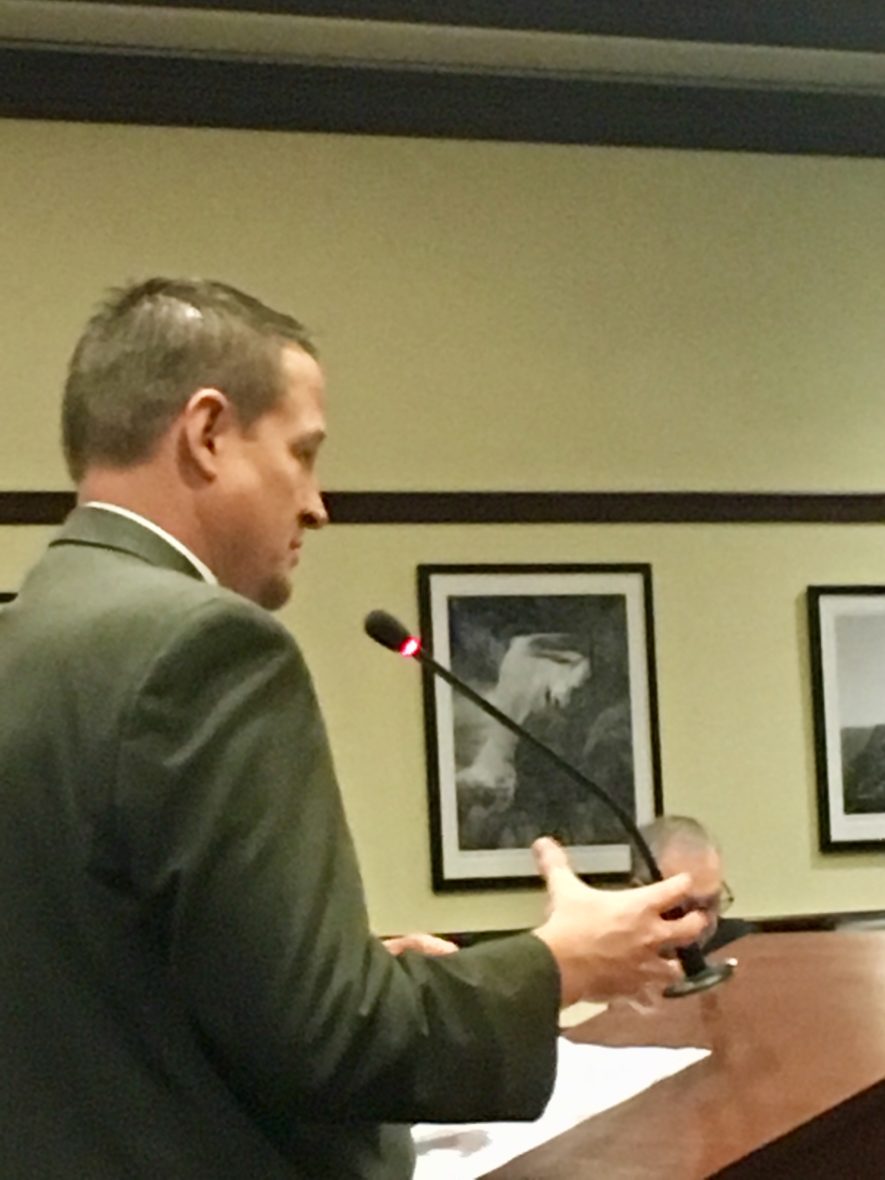A divided House State Affairs Committee introduced a bill to allow anyone with an enhanced concealed weapons license to bring a gun into a public school.
But this first step in the legislative process was anything but routine — foreshadowing more heated debate to come. As lawmakers asked pointed questions about the bill, dozens of supporters and opponents packed the committee room, and others watched a video stream in an adjoining room.

First-term Rep. Chad Christensen couched his once-delayed bill in the context of the Second Amendment, saying no local government should have the right to infringe on gun owners. But Christensen also described schools as a “soft target,” and said armed principals or teachers could help prevent a school shooting.
“This is my entire goal, to protect children,” said Christensen, R-Ammon.
Schools can already allow faculty or staff to carry weapons — and several districts and charters do just that. Christensen’s bill would essentially take school boards out of this decisionmaking process, and allow enhanced concealed weapons license-holders to carry weapons, without restrictions.
Christensen pointed out that an enhanced license-holder must be at least 21 years old — which means students couldn’t bring guns to school — and must take a one-day course and demonstrate proficiency in using a firearm.
“It has some teeth to it,” he said.
Rep. John Gannon, D-Boise, led the opposition.
“I see this as an assault on local control and local decisionmaking,” he said.
Gannon listed several specific concerns with the wording. License-holders would be allowed to carry a firearm to school, no questions asked — and that means a principal couldn’t ask if a staffer or visitor had a gun, even in the midst of an attack.
“That school principal needs to have the authority to investigate,” Gannon said.
Gannon made an unsuccessful motion to hold the bill, supported by fellow Democrats Elaine Smith of Pocatello and Brooke Green of Boise and Republican Linda Wright Hartgen of Twin Falls. Moments later, the committee voted to introduce the bill, on an identical voice vote.
Introductory hearings — or print hearings — are normally brief. But in this case, the committee spent nearly 30 minutes questioning Christensen.
The public did not have a chance to testify, but the fault lines were visible Tuesday. Several members of the audience were members of Everytown for Gun Safety, wearing red t-shirts that read, “Moms demand action for gun sense in America.” Other audience members wore shirts and hoodies promoting the Three Percenters, a group that opposes gun control.
Many members of the audience were Eagle High School students — and their attire gave no inkling of where they stood on the bill.
With State Affairs’ vote Tuesday, Christensen’s bill is poised to come back for a full public hearing.
Minimum teacher salary bill sails through House
With no debate — and only a pocket of opposition — the House endorsed a bill to increase Idaho’s minimum teacher salary to $40,000 over two years.
One of Gov. Brad Little’s top priorities for the session, House Bill 153 would require schools to pay a minimum salary of $38,500 next year. The required $40,000 salary would kick in the following year.
The bill’s floor sponsor, first-year Rep. Gary Marshall, wove a personal tale into his overview. A retired professor, Marshall was a new teacher at East Idaho’s Bonneville High School in 1973. He loved his new job, he said, but had to work a second job at night to make ends meet.
“Starting teaching pay is important in getting young people into the teaching profession,” said Marshall, R-Idaho Falls.
Boosting the minimum salary could also stem the tide of teachers who leave the profession, or leave the state for better-paying classroom jobs in neighboring states.
The bill would cost $3.8 million in the first year, and $7.6 million in the second year.
No other lawmakers debated the bill. It passed on a 61-9 vote, with opposition coming from a smattering of conservative Republicans: Vito Barbieri of Dalton Gardens; Terry Gestrin of Donnelly; Priscilla Giddings of White Bird; John Green of Post Falls; Steven Harris of Meridian; Tammy Nichols of Middleton; Heather Scott of Blanchard; Julianne Young of Blackfoot; and Christensen.
HB 153 now goes to the Senate.
JFAC approves higher education budget
Following a recurring pattern, the Legislature’s budget-writers quickly and unanimously approved another big education budget Tuesday morning.
Idaho’s college and university system is in line to receive a $306 million general fund budget next year, under the Joint Finance-Appropriations Committee’s spending plan.
This would translate to a 3.5 percent general fund increase. By comparison, JFAC last week approved a 6.1 percent spending increase for K-12.
Among the line items in the higher education budget: $150,000 to set up a single online platform where students can enroll in dual-credit classes; and $50,000 to pilot open-source electronic college textbooks.
The higher education budget will still have to go to the House and the Senate for votes, before going to Little’s desk. It’s not unheard of for a budget bill to fail on a floor vote, but it is unusual.
JFAC still has to draw up budgets for community colleges and the Idaho Opportunity Scholarship. That’s on the schedule for next week.
